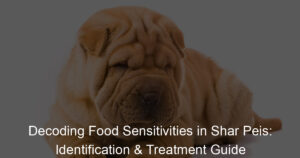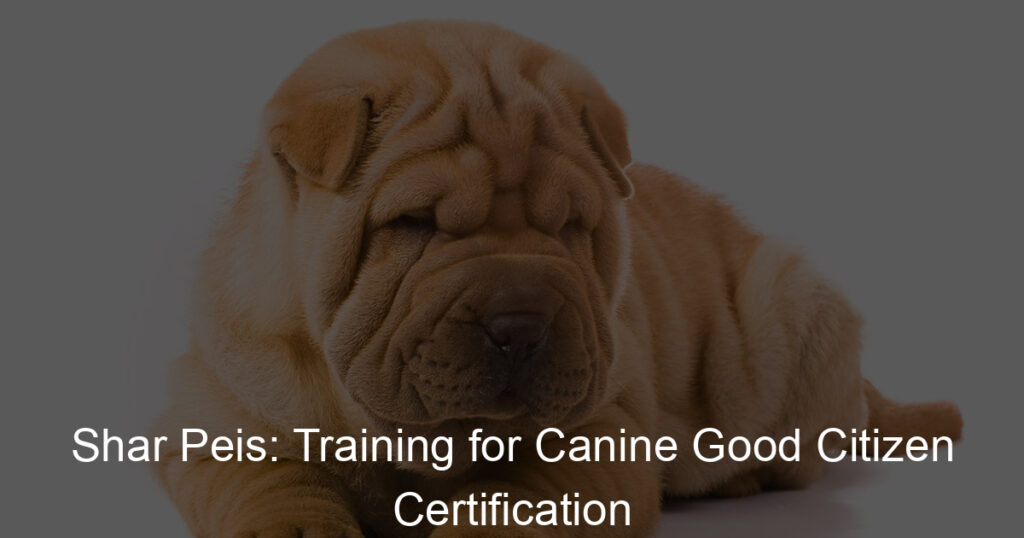
Introduction
Welcome to our comprehensive guide on understanding and addressing the fear of thunder in Shar Pei dogs. This blog post aims to provide valuable insights into the nature of this phobia, its importance, and how to manage it effectively. We’ve simplified the information to make it easily understandable for everyone, even those without a background in animal behavior.
- Understanding the fear of thunder in Shar Pei: The Shar Pei, a breed known for its unique wrinkled skin and blue-black tongue, is also recognized for its brave and loyal nature. However, like many dogs, they can develop a fear of thunderstorms. This fear is not just about the loud noises; it can also be triggered by changes in barometric pressure, static electricity, and even the smell of rain. Understanding this fear is the first step towards helping your pet.
- Importance of addressing dog phobias: Fear of thunderstorms in dogs is not something to be ignored. It can lead to severe anxiety and stress, affecting their overall health and quality of life. Moreover, a fearful dog can become destructive, causing harm to themselves and their surroundings. Therefore, addressing these phobias is crucial for the well-being of your pet and the harmony of your home.
Throughout this blog post, we will delve deeper into the topic, discussing the specifics of thunderstorm anxiety in dogs, how it manifests in Shar Peis, and practical ways to manage and alleviate this fear. We hope this information will be helpful for all dog owners, particularly those who share their lives with a Shar Pei.
Understanding Thunderstorm Anxiety in Dogs
Thunderstorms can be a source of fear and anxiety for many dogs. This fear can be particularly pronounced in certain breeds, such as the Shar Pei. In this section, we will delve into the behavior problems associated with thunderstorm anxiety in Shar Peis.
Shar Pei Behavior Problems
Shar Peis are known for their unique appearance and loyal nature. However, like any breed, they can experience certain behavior problems. One such issue is thunderstorm anxiety. Let’s explore the common signs of this anxiety and understand the fear response in Shar Peis.
- Common signs of thunderstorm anxiety in Shar Pei
- Understanding the fear response in Shar Peis
During a thunderstorm, a Shar Pei may exhibit several signs of anxiety. These can include restlessness, excessive barking, shaking, hiding, and even destructive behavior. They may also show physical symptoms such as drooling, panting, or pacing. It’s important to note that not all Shar Peis will react in the same way, and some may show only subtle signs of distress.
The fear response in Shar Peis during thunderstorms can be attributed to a variety of factors. These can include the loud noises, changes in atmospheric pressure, and the flashing lights associated with storms. This fear response is a survival instinct, as the dog perceives the storm as a threat. Understanding this can help owners better manage their pet’s anxiety.
In conclusion, thunderstorm anxiety is a common issue in Shar Peis, and understanding the signs and fear response can help owners provide the necessary support and comfort to their pets during these stressful times.
Dog Anxiety Treatment
When it comes to treating anxiety in dogs, especially during thunderstorms, there are two main approaches that pet owners can take. These include seeking professional help for severe cases and using home remedies for mild anxiety. Let’s delve into each of these options to understand them better.
- Professional Help for Severe Cases
If your dog’s anxiety is severe, it’s best to seek professional help. This could be from a veterinarian or a certified animal behaviorist. These professionals have the knowledge and experience to diagnose and treat anxiety in dogs.
They may recommend a combination of treatments such as medication, behavior modification, and environmental changes. For instance, they may prescribe anti-anxiety medication to help your dog cope during thunderstorms. Behavior modification techniques, like desensitization and counter-conditioning, can also be used to change your dog’s reaction to thunderstorms.
Remember, it’s important to follow the professional’s advice and treatment plan to ensure your dog’s anxiety is managed effectively.
- Home Remedies for Mild Anxiety
For dogs with mild anxiety, home remedies can often be effective. These remedies are simple techniques that you can implement at home to help your dog feel safe and secure during thunderstorms.
One popular home remedy is the use of a ‘safe space’. This is a quiet, comfortable area in your home where your dog can retreat to during a storm. It could be a specific room, a crate, or even a closet. The idea is to create a space where your dog feels safe and secure.
Another remedy is the use of calming music or white noise. Studies have shown that certain types of music can have a calming effect on dogs. Similarly, white noise can help to mask the sound of thunder, reducing your dog’s anxiety.
Keep in mind, what works for one dog may not work for another. It’s important to try different remedies and see what works best for your dog.
Thunderstorm Phobia in Shar Peis
Thunderstorm phobia is a common issue among many dog breeds, including Shar Peis. This fear can cause significant distress for your pet. However, there are effective strategies to help calm your dog during storms.
Calming Dogs During Storms
When a thunderstorm hits, your Shar Pei may become anxious and scared. Here are two strategies that can help soothe your dog’s fears:
- Creating a Safe Space: One of the most effective ways to calm your Shar Pei during a storm is by creating a safe space. This could be a specific room or a corner in your home where your dog feels secure. Make sure this area is comfortable and free from loud noises. You could add their favorite toys or a familiar blanket to make the space more inviting.
- Using Calming Music or White Noise: Another effective strategy is to use calming music or white noise. These sounds can help mask the noise of the thunderstorm, reducing your dog’s anxiety. There are many apps and devices available that play calming sounds specifically designed for dogs.
Remember, every dog is unique and what works for one might not work for another. It’s important to try different strategies and see what works best for your Shar Pei.
Understanding and addressing your dog’s fear of thunderstorms can significantly improve their quality of life. By creating a safe space and using calming sounds, you can help your Shar Pei feel more secure during storms.
Shar Pei Anxiety Symptoms
Just like humans, Shar Peis can also experience anxiety. It is crucial to identify the symptoms and know how to respond appropriately to ensure your pet’s well-being.
- Identifying Symptoms of Anxiety
- Excessive barking or howling: If your Shar Pei is barking or howling more than usual, especially during a thunderstorm, it might be a sign of anxiety.
- Pacing: An anxious dog often paces back and forth or in circles.
- Shaking or trembling: This is a clear sign of fear or anxiety in dogs.
- Excessive licking or chewing: Dogs often lick or chew on their bodies excessively when they’re anxious.
- How to Respond to These Symptoms
- Provide a safe space: Create a quiet, comfortable area where your dog can retreat during a thunderstorm or when feeling anxious.
- Use calming music or white noise: Soft music or white noise can help calm your dog and reduce their anxiety.
- Consult a vet: If your Shar Pei’s anxiety symptoms persist, it’s best to consult a vet. They can provide professional advice and treatment options.
Recognizing the signs of anxiety in your Shar Pei is the first step towards helping them. Here are some common symptoms:
Remember, every dog is unique, and these symptoms can vary from one Shar Pei to another.
Once you’ve identified the symptoms of anxiety in your Shar Pei, it’s time to take action. Here’s what you can do:
Remember, patience and understanding are key when dealing with an anxious dog. It’s important to provide them with the comfort and support they need.
Managing Fear in Dogs
One of the most challenging aspects of pet ownership is managing your dog’s fear. Fear in dogs can manifest in various ways, such as barking, whining, or hiding. However, with the right training techniques, you can help your furry friend overcome their fears.
Training Techniques
There are two main training techniques that can help manage fear in dogs: Desensitization and Counter-conditioning. These methods are proven to be effective and are recommended by many professional dog trainers.
-
Desensitization
Desensitization is a gradual process that involves exposing your dog to the thing they fear in a controlled manner. For instance, if your dog is afraid of thunderstorms, you might start by playing a recording of a thunderstorm at a very low volume. Over time, you can slowly increase the volume as your dog becomes more comfortable. This technique helps your dog to associate the thing they fear with normalcy, reducing their fear response.
-
Counter-conditioning
Counter-conditioning, on the other hand, involves changing your dog’s emotional response to the thing they fear. This is done by pairing the fear-inducing stimulus with something your dog enjoys. For example, if your dog is afraid of strangers, you might give them a treat every time a stranger approaches. This helps your dog to associate strangers with positive experiences, reducing their fear.
Remember, patience is key when using these techniques. It may take some time for your dog to overcome their fear, but with consistent training, they can learn to manage their fear effectively.
Medication and Supplements
It’s important to understand that sometimes, training techniques may not be enough to manage your dog’s fear of thunderstorms. In such cases, medication and supplements can be considered. Let’s explore when to consider medication and what safe and effective supplements are available.
- When to Consider Medication
Medication should be considered as a last resort when all other methods have failed to alleviate your dog’s fear. If your dog’s anxiety is so severe that it’s affecting their quality of life, it might be time to consider medication. For instance, if your dog refuses to eat, becomes overly aggressive, or hides for hours after a storm, these are signs that medication may be necessary. Remember, it’s always best to consult with a vet before starting any medication regimen.
- Safe and Effective Supplements
There are several safe and effective supplements that can help manage your dog’s thunderstorm anxiety. These include:
| Supplement | Benefits |
|---|---|
| Chamomile | Chamomile is a natural calming agent that can help soothe your dog’s nerves. |
| Valerian Root | Valerian root is often used to treat insomnia and anxiety in humans, and it can have the same calming effect on dogs. |
| Passion Flower | Passion flower can help reduce restlessness and agitation in dogs. |
Remember, just like with medication, it’s important to consult with a vet before starting any supplement regimen. Supplements can interact with other medications your dog may be taking, so it’s crucial to discuss this with a professional.
Conclusion
As we wrap up this informative journey, let’s take a moment to recap the key takeaways and share some final thoughts on managing thunderstorm fear in your Shar Pei.
- Recap of Key Takeaways
- Final Thoughts on Managing Thunderstorm Fear in Your Shar Pei
Firstly, we learned that thunderstorm anxiety is a common issue among dogs, particularly in Shar Peis. This fear can manifest in various ways, such as trembling, hiding, or even destructive behavior.
Secondly, we discovered that this fear can be managed effectively. By creating a safe space for your Shar Pei during storms, using calming techniques like swaddling or playing soothing music, and consulting with a veterinarian for possible medication, you can help your pet cope with their fear.
Lastly, we emphasized the importance of patience and understanding. Remember, your Shar Pei is not misbehaving out of defiance but reacting out of fear. Your support and reassurance can make a world of difference.
Managing thunderstorm fear in your Shar Pei may seem like a daunting task, but with the right approach, it is entirely possible. The key is to be patient, consistent, and understanding. It’s also important to remember that every dog is unique, so what works for one might not work for another.
As a responsible pet owner, your role is to provide a safe and comforting environment for your Shar Pei. By doing so, you can help them navigate their fear and improve their overall quality of life. Remember, your pet relies on you for their well-being, and with your help, they can overcome their fear of thunderstorms.














